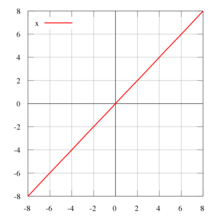
In mathematics, an identity function, also called an identity relation or identity map or identity transformation, is a function that always returns the same value that was used as its argument. In equations, the function is given by f(x) = x.
== Definition ==
Formally, if M is a set, the identity function f on M is defined to be that function with domain and codomain M which satisfies
f(x) = x for all elements x in M.In other words, the function value f(x) in M (that is, the codomain) is always the same input element x of M (now considered as the domain). The identity function on M is clearly...